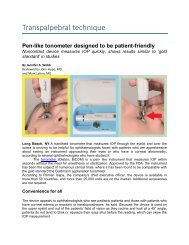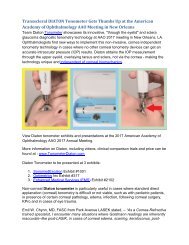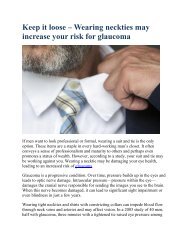Finding the Best Tonometer for your Practice – IOP in Optometry & Ophthalmology
http://www.TonometerDiaton.com- It’s easy to get lost while looking for the Best Tonometer as there are a few tonometry options: applanation, handheld, desktop, noncontact, airpuff, rebound, indentation, non-corneal, through the eyelid / transpalpebral, scleral, pen-like tonometers. Tags:- Tonometer, Tonometry, Optometry, Ophthalmology, Glaucoma,
http://www.TonometerDiaton.com-
It’s easy to get lost while looking for the Best Tonometer as there are a few tonometry options: applanation, handheld, desktop, noncontact, airpuff, rebound, indentation, non-corneal, through the eyelid / transpalpebral, scleral, pen-like tonometers.
Tags:-
Tonometer, Tonometry, Optometry, Ophthalmology, Glaucoma,
Create successful ePaper yourself
Turn your PDF publications into a flip-book with our unique Google optimized e-Paper software.
<strong>F<strong>in</strong>d<strong>in</strong>g</strong> <strong>the</strong> <strong>Best</strong> <strong>Tonometer</strong> <strong>for</strong> <strong>your</strong> <strong>Practice</strong> <strong>–</strong> <strong>IOP</strong><br />
<strong>in</strong> <strong>Optometry</strong> & <strong>Ophthalmology</strong><br />
It’s easy to get lost while look<strong>in</strong>g <strong>for</strong> <strong>the</strong> <strong>Best</strong> <strong>Tonometer</strong> as <strong>the</strong>re are a few tonometry options:<br />
applanation, handheld, desktop, noncontact, airpuff, rebound, <strong>in</strong>dentation, non-corneal, through<br />
<strong>the</strong> eyelid / transpalpebral, scleral, pen-like tonometers.<br />
There is also a list of manufactures to pick from: HAAG-STREIT, 66Vision, Canon, Cso,<br />
DIATON, Huvitz, Essilor, Icare, Luneau, Kangjie, Keeler, Kowa, Macro, BiCOM, Nidek,<br />
Oculus, Reichert, Rexxam, Rodenstock, Swowei, Tomey, Accutome, Topcon, Ziemer just to<br />
name a few.<br />
Each Tonometry Option has its Benefits, Advantages and Limitations.<br />
Tonometry devices can be broken up to 2 Ma<strong>in</strong> Categories:<br />
1. Corneal Tonometry <strong>–</strong> where <strong>in</strong>traocular pressure (<strong>IOP</strong>) is measured by ei<strong>the</strong>r<br />
<strong>in</strong>dent<strong>in</strong>g or applanat<strong>in</strong>g <strong>the</strong> cornea. Contact with <strong>the</strong> cornea and numb<strong>in</strong>g drops might be<br />
required with some corneal tonometers (ex: Goldmann, Tonopen) and not o<strong>the</strong>rs, such as<br />
Airpuff.
2. Non-Corneal or Scleral Tonometry <strong>–</strong> this <strong>in</strong>novative tonometry category is<br />
represented by a s<strong>in</strong>gle brand <strong>the</strong> Transpalpebral DIATON tonometer. Diaton presents an<br />
<strong>in</strong>novation due to its technique and ballistic pr<strong>in</strong>ciple, which is based on Newton’s<br />
second law of motions:<br />
F net = m • a<br />
Diaton tonometer allows to measure <strong>IOP</strong> through <strong>the</strong> upper eyelid and sclera. Unlike all o<strong>the</strong>r<br />
cornea dependent tonometry devices, <strong>IOP</strong> with Diaton is not <strong>in</strong>fluenced by known and still<br />
unknown biometric properties of <strong>the</strong> cornea. Pachymetry is not required to adjust <strong>the</strong> read<strong>in</strong>gs<br />
<strong>for</strong> <strong>the</strong> central corneal thickness (CCT), as with Diaton device, <strong>the</strong> operat<strong>in</strong>g pr<strong>in</strong>ciple and <strong>the</strong><br />
technique completely elim<strong>in</strong>ates <strong>the</strong> <strong>in</strong>fluence of <strong>the</strong> cornea. <strong>IOP</strong> is measured above <strong>the</strong> edge of<br />
<strong>the</strong> limbus, with Diaton tonometers tip placed on <strong>the</strong> upper eyelid at tarsus and sclera.<br />
Goldmann applanation tonometry (GAT) is <strong>the</strong> gold standard <strong>for</strong> measur<strong>in</strong>g <strong>IOP</strong> and most<br />
probably will cont<strong>in</strong>ue to be so <strong>in</strong>to <strong>the</strong> near future. However, its limitations were obvious from<br />
<strong>the</strong> start and <strong>in</strong>clude <strong>the</strong> substantial effects of several eye variables such as axial length,<br />
curvature, rigidity and corneal thickness. Also, <strong>in</strong> some eyes, especially those with corneal<br />
problems (such as diseases, trauma, haze, corneal opacities, leucomas, etc.) and surgery, tak<strong>in</strong>g<br />
measurements is not easy.<br />
Thus <strong>the</strong> option of transpalpebral, scleral tonometry with Diaton tonometer makes it a more<br />
versatile tonometry option <strong>for</strong> practices that already have GAT and are seek<strong>in</strong>g <strong>for</strong> a handheld,<br />
cornea <strong>in</strong>dependent read<strong>in</strong>gs.<br />
Non-corneal tonometry methodology was cl<strong>in</strong>ically tested at MEEI/Harvard Medical School by<br />
Dr. Mark Lat<strong>in</strong>a and colleagues <strong>–</strong> where Diaton provided a new and unique way of look<strong>in</strong>g at<br />
<strong>IOP</strong> completely <strong>in</strong>dependent of corneal biometrics as <strong>the</strong> read<strong>in</strong>g with Diaton is done via eyelid<br />
and more importantly <strong>the</strong> sclera, not through <strong>the</strong> cornea as all o<strong>the</strong>r tonometers.<br />
<strong>Tonometer</strong> Diaton is <strong>the</strong> perfect solution <strong>in</strong> <strong>the</strong> follow<strong>in</strong>g cases when <strong>the</strong> use of o<strong>the</strong>r tonometry<br />
devices is problematic or impossible: Keratitis, Conjunctivitis, Keratotone, Cornea Dimness,<br />
Keratopros<strong>the</strong>sis, Keratoplastics, LASIK, LASEK, PRK, Astigmatism, Ametropy, etc.,
Product Features & Major Benefits:<br />
• Easy to use. Handheld, portable, pen-like device<br />
• No contact with <strong>the</strong> cornea (only upper eyelid and sclera)<br />
• No need <strong>for</strong> anes<strong>the</strong>sia drops or removal of contact lenses<br />
• Safe: No risk of <strong>in</strong>fect<strong>in</strong>g or scratch<strong>in</strong>g cornea<br />
• Cost efficient: No consumables (no need to purchase replacement<br />
tips/covers, etc.)<br />
• No sterilization (just alcohol swab is used to wipe off <strong>the</strong> tip)<br />
• Accurate: No pachymetry needed (<strong>in</strong>dependent of cornea)<br />
• Ready-to-use: Daily calibration not required<br />
Diaton <strong>Tonometer</strong> <strong>in</strong> Action:<br />
How to Use Tonometry Over Eyelid with <strong>Tonometer</strong> DIATON<br />
Video taken at <strong>the</strong> Academy of <strong>Ophthalmology</strong> AAO- click image to watch video<br />
Q&A on Benefits and Advantages of Diaton tonometer by Glaucoma and Cornea<br />
specialists from Harvard/MEEI Dr. Mark Lat<strong>in</strong>a and Dr. Emil Chynn
Review Diaton tonometer Quick Start Guide:<br />
F<strong>in</strong>d more cl<strong>in</strong>ical details, price and order options at<br />
www.<strong>Tonometer</strong>Diaton.com






